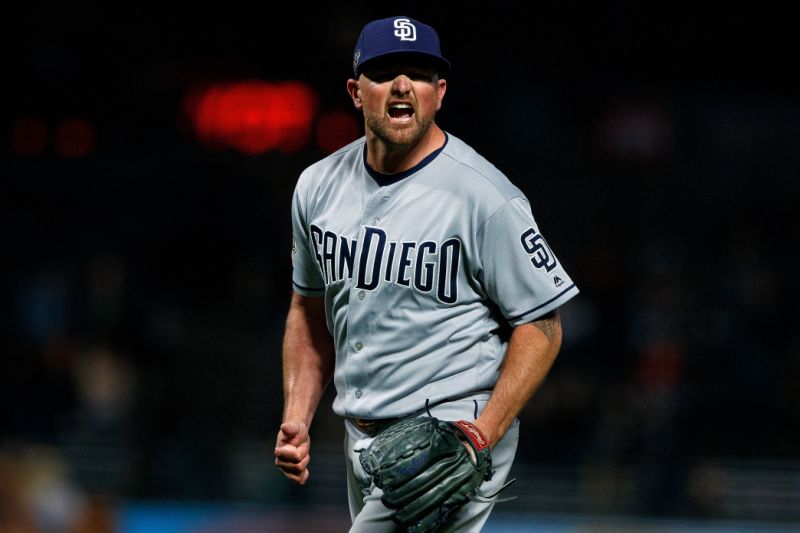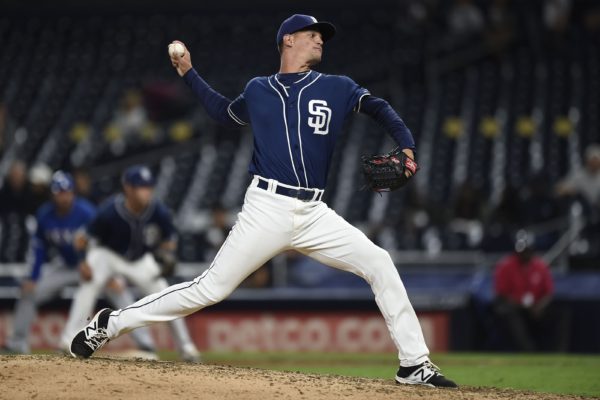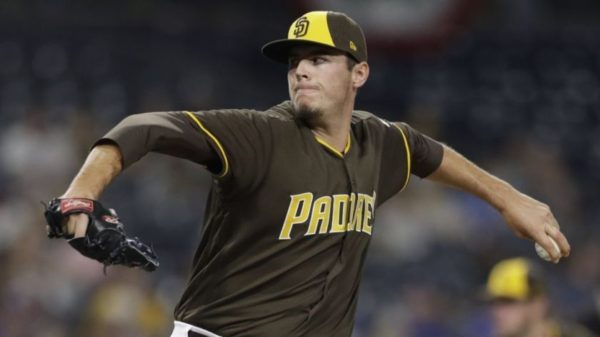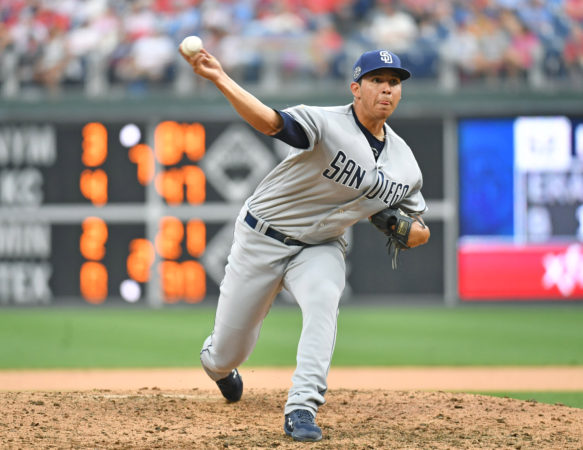2019 San Diego Padres Final Grades: Relief Pitchers

Credit: USA Today Sports

Grade: A-
As one of several young arms to make their debut with the Padres pitching staff in 2019, Baez impressed many early on in his first taste of major league action. In just under 3o innings with San Diego, Baez had an impressive ERA+ of 141 along with nearly a strikeout an inning and less than a homer allowed per nine innings pitched. The 6’8″ Cuban righty has been in the Padres system since 2017 and had been used exclusively as a starter before transitioning to a relief role when he arrived at Double-A Amarillo this year. He saw great success in the Texas League, which ultimately led to his midseason promotion. Baez’s plus fastball that clocks in the high 90’s may eventually play best out of the bullpen where he’s almost sure to see the bulk of his work with the Padres over the next few seasons, but he can also still provide a valuable role as a spot starter.
Grade: F
Once one of the top prospects in the Padres farm system, Wisler was traded to the Atlanta Braves shortly before the start of the 2015 season during the offseason of Preller-palooza in the deal that brought Craig Kimbrel and Melving Upton Jr. to San Diego. Almost four years to the day later, Wisler was reacquired by San Diego from Cincinnati in exchange for minor leaguer Diomar Lopez. He began 2019 pitching out of the bullpen, where he continued to be victimized by the longball struggles that have plagued him since making his debut in 2015. Despite posting what was by far the highest strikeout rate of his career at 10.6 K/9, his 1.517 WHIP and ERA north of five provided little value to a team who had rising prospects who needed fed innings against major league talent. Wisler was eventually DFA’d by the Padres and would finish the season with the Seattle Mariners.

Grade: F
Signed to a one year deal in the offseason with a team option for 2020, Adam Warren will almost certainly find himself on the market again this winter as he struggled mightily through the early stretches of the season and eventually saw his campaign end prematurely as he was placed on the IL in June and never returned to the active roster. In his 28.2 innings, Warren posted similar numbers to Matt Wisler but with fewer strikeouts and an obscenely high HR/9 rate of 2.8. Expected to be a veteran presence who could provide valuable late-game help after a pair of successful years with the Yankees and Mariners, Warren never really delivered on those expectations as things got off to a rocky start right away with five home runs allowed in just thirteen innings between April and March. It’s hard to imagine Warren getting anything other than a minor league deal when he enters free agency.
Grade: D
After making his debut, the young Mexican right-hander never seemed to be able to work his way out of trouble. Despite high strikeout numbers like a 13.2 K/9 and a 1.346 WHIP that was fairly in line with what he had done coming up in the minors, like most pitchers he saw his home run rate skyrocket this year as he allowed eleven between El Paso and San Diego after not giving up more than three in any prior season. It’s possible the new ball had quite a bit to do with this increase, and there are plenty of signs that Reyes’s high ERA was an aberration, like his FIP being 4.21 runs lower than his ERA. Reyes will still just be 26 at the start of next season and should be back with the chance to grow and develop more like a productive major league reliever.

Grade: D
Brad Wieck’s second season seeing time in the majors, went about as poorly as one could expect. He was hammered in his 24.2 innings with the Friars as seven balls left the yard during that span for an HR/9 of 2.6. He also saw a dip in his strikeout numbers compared to his limited action in 2018 as he struck out more than a batter less every nine innings. His 1.419 WHIP and 6.57 ERA eventually led the Padres to trade him to the Chicago Cubs in exchange for Carl Edwards Jr. in the hopes that a change of scenery would be beneficial for both struggling relievers. In the end, Wieck found success with the Cubs over the final stretch of the season with a 128 ERA+ over ten innings while Edwards gave up six earned runs while walking four in just 1.2 innings for San Diego.
Grade: F
Maton struggled for much of his time with the Padres in 2019 as he continued to struggle to deliver on the lofty expectations that were placed in him when he quickly arrived in the majors in 2017 after being taken in the 20th round during the 2015 draft. After posting a 0.6 HR/9 rate in 2018, Maton got rocked to a rate of 2.2 with San Diego through the first few months of the season. His ERA ballooned to 7.77, and his ERA+ cratered to an abysmal 55 as he was allowing nearly thirteen hits per nine innings. Despite a drop in his walk rate, he was suddenly striking out less than a batter an inning and was ultimately traded to the Cleveland Indians on July 12th for international bonus slot money. Like Wieck, he recovered with his new team to post a strong finish to the season as his strikeout rate recovered, and he posted an ERA below three in just over twelve innings with the Tribe.
Grade: B+
The young Mexican flamethrower impressed early on following his debut in July. Following dominating stints in Amarillo and El Paso, Munoz was promoted to breathe some life into a struggling Padres bullpen that was limping through July. Munoz quickly blew away Padres fans and opposing batters with a wipeout slider that complimented a fastball that regularly topped in at 100+ MPH and clocked in as the fastest pitches thrown by a Padres pitcher in the Statcast era. The 20-year-old finished his first MLB season with a 1.174 WHIP and 11.7 K/9 across 23 innings while allowing just two home runs. In August, he also picked up his first career save, becoming the youngest Padre pitcher ever to do so. Widely considered the Padres closer of the future, Munoz is likely to settle into an eight-inning role next year if Yates is still pitching in San Diego.

Grade: B+
At 29, Yates was one of the older players to make their MLB debut this season but put up respectable numbers in just 11.2 innings of work. Yardley’s funky sidearm delivery makes him a bit harder for hitters to read when he’s on the mound. He had always been a pitch-to-contact guy in the minors, and that continued with the big league club as he struck out just seven batters during his stint. With his 1.286 WHIP and .668 opponent OPS, Yardley managed to limit significant damage despite being a soft tosser who primarily throws a sinker and slider. However, at 29, it’s hard to see Yardley in the organization’s plans for the future, and his call up may have been nothing more than a chance for other teams to get a look at him against major league competition for a potential winter deal to clear 40-man room.
Grade: A
Quantrill was used primarily as a starter during his first season, but there was a stretch where he was used as a reliever over five games and 11.1 innings. Quantrill fully embraced his brief stint in the bullpen and capitalized on it with fantastic numbers, holding opposing hitters to a .154/.233/.154 line as he didn’t give up a single extra-base hit. Quantrill is likely a number 4 or 5 starter long term, but his flexibility and success out of the bullpen this year will give the Padres’ options as more of their top pitching prospects rise to the big league club in 2020.
Grade: B-
Bednar’s deceptive 6.55 ERA is inflated by a rough final appearance in Arizona during game 161, where he allowed five earned runs in 0.2 innings. Before that, he had posted a 2.61 ERA in 10.1 innings dating back to when rosters expanded on September 1st. Bednar was promoted directly from Amarillo, and the 24-year old’s early success was a pleasant surprise as, despite a track record of success in the minors, he was often overshadowed by names likes Munoz, Reyes, and Baez. Bednar struck out fourteen hitters over his eleven innings and had only allowed a single homer before giving up one in each of his final two appearances on the season. Bednar’s age and early effectiveness work very strongly in his favor, and the Padres will be going into 2020 with plenty of bullpen spots up for grabs.
[wpedon id=”49075″ align=”left”]
Grade: F
Following a surprising rookie campaign in 2018, Stock struggled mightily in limited action in 2019. Stock spent the offseason working on his high-velocity fastball in an attempt to miss more bats this season, and he did achieve an over four-point rise in his strikeout rate. However, he also wholly lost control of the zone as he was now walking nearly seven batters per nine innings. This would ultimately spell his undoing as his ERA rose to over ten, and he was quickly demoted and spent much of the season in El Paso where his command problems continued despite him doing better at working around the walks. At nearly 30 years old, there simply won’t be a place for Stock in San Diego next season, and he will undoubtedly be one of the roster crunch victims in the coming months. Stock previously reinvented himself as a flamethrower after initially struggling as a catcher in the minor leagues, so it would not be surprising if he does end up finding success elsewhere much like Brad Hand and Kirby Yates did when they arrived in San Diego as waiver claims.
Growing up in Dodgers country, Bradley would proudly display his Padres fandom through the roughest years of non competitiveness and rebuilding. With the Padres on the verge of contending, he’s excited to get the opportunity to cover them on a regular basis along with their minor league system.
^ agree with Tom. Seems like an anecdotal grade, not a statistically based one. He may have regressed a bit but was still well above average. Stammen was legit this year and was super overworked by green.
Stammen was actually pretty good. His numbers were torpedoed by 2 games in June, when an idiot manager, who had been overworking him since opening day like a farm animal, left him in to give up 4 runs twice in a 13 day span. If he had been pulled after 2 runs, as would have been normal, his ERA would only be 2.85, and we’d be looking at B+ instead of a C+.